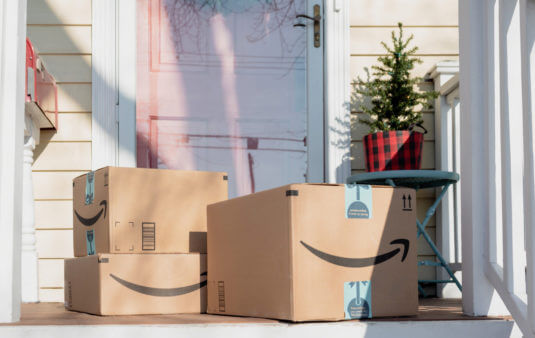What Prime Day signals for 2020 holiday retail
Here’s what marketers should expect, plan for and start doing now to maximize sales and revenue this season.
Amazon Prime Day sales hit $10.4 billion globally, according to an estimate from Digital Commerce 360. That would mark a 45% jump over last year’s event in July. Amazon itself declined to give overall revenue numbers, but said third-party sellers sold $3.5 billion worth of goods on the marketplace over last week’s two-day Prime Day event.
How Prime Day ad campaigns performed
Advertising spend on Amazon increased by 3.8X compared to the daily average of the 30 days leading up to the event, according to campaign management platform Kenshoo. That’s the same increase the company saw during Prime Day a year ago when the event ran as usual in July.
Kenshoo says advertising-driven conversions were up 2.6X this year and that advertiser sales revenue was up 4.9X compared to the previous 30-day average. However, that’s down from last year when advertisers running campaigns via Kenshoo saw sales revenue increase by 5.8X compared to the days leading up to the event.
The increased competition for online shoppers meant lower return on ad spend (ROAS) as spend and the cost of bids rose in some categories. “Despite a 187% increase in impressions, Home and Kitchen, for instance, saw ROAS drop by nearly 50% compared to last year, in part due to a nearly three-fold increase in ad spend. Clothing, Shoes, and Jewelry experienced a similar effect, with ROAS declining by 4% from Prime Day last year,” said product feed solution Feedvisor.
Some brands saw CPCs come in at more than a dollar over forecast, performance agency PMG said.
Beauty and Personal Care and Electronics were standouts, however, said Feedvisor. Beauty and Personal Care saw a 210% increase in sales on 146% increase in ad spend. ROAS for the category was up 26% from last year. Electronics advertisers saw ROAS increase by 58% over Prime Day 2019.
The Prime Day halo effect?
Again this year, other retailers saw some halo effect of Prime Day with traffic. More than half of the top 100 online retailers ran concurrent sales on Tuesday, Digital Commerce 360 found. Sales and conversion rates went up on U.S. retailer sites: Traffic increased 17% and conversion rates rose 16% over Tuesday of the prior week. Compared to day one of Prime Day 2019, traffic to U.S. retailer sites was up 51% and conversion rates increased by 13%, according to Salesforce data.
Advertisers saw solid results from sponsored product ads on retailer sites such as Target and Best Buy. However, only one or two brands saw 10x day-over-day demand increase during the Prime Day sale period from their non-Amazon retailer campaigns, according to performance agency PMG. “This scenario proved that for a majority of brands, it was as if Prime Day was a normal pre-holiday day and not the start of this year’s holiday sales season,” the agency told us.
Amazon garnered the overwhelming majority of online spending during Prime Day, with 91.6% of market share during the first 30 hours of the event, Edison Trends found. Walmart had a 3.4% share while Best Buy had 3.0%.
In-store & local shopping outlook
In-store shopping is down, but not dead. More than one-third (35%) of consumers noted that they had shopped in-store for clothing, footwear, or accessories in the past 30 days, and almost all of them had made a purchase, according to an NPD/CivicScience poll conducted in late August.
Shifting consumer behavior has accelerated online-to-offline buying during this time. Curbside pickup is now table stakes. This trend, too, is likely to stick.
Local businesses have been hit especially hard during the pandemic, but consumers say they are interested in supporting them. Google’s survey found 66% of U.S. holiday shoppers say they will shop more at local small businesses.
NPD also notes there will still be last-minute shoppers in 2020. “Despite the increased digital focus, stores will also play an important role this year, particularly since shipping options will become limited as the holiday approaches. Options like buy online pick-up-in-store and curbside pickup will be key,” says The NPD Group, a data and analytics consultancy.
Consumer holiday shopping outlook
Despite the economic hardships caused by the pandemic, 72% of consumers said they plan to spend the same or more this year compared to the 2019 holiday season, according to consumer research from Feedvisor. More than one-third (35%) said they plan to do all or almost all of their holiday shopping online compared to 25% who did so last year, the survey found.
An earlier start. Even without the prompt of Prime Day, many consumers were planning to start shopping earlier. In the U.S., 62% of consumers said they’ll start holiday shopping earlier to avoid crowds, Google found.
Further, 33% of consumers plan to complete their holiday shopping much earlier this year compared to last year, according to a Feedvisor survey.
Gaining early visibility and sustaining marketing momentum will be key. Marketers should promote fast (and reliable) shipping, buy-online-pick-up in-store/curbside and carefully targeted incentives.
Don’t wait for Thanksgiving week to start dialing up your campaigns this year.
That also means keeping a close eye on inventory levels to account for any possible supply chain challenges. Many brands and retailers are likely to see stock-outs.
Merchants sending inventory to Amazon for fulfillment, for example, should plan to ship as early as possible due to the ongoing logistical challenges Amazon faces. Important dates to note:
- Inventory for Black Friday and Cyber Monday should arrive at Amazon fulfillment centers by November 6.
- Inventory for Christmas shopping should arrive at Amazon fulfillment centers by December 1.



